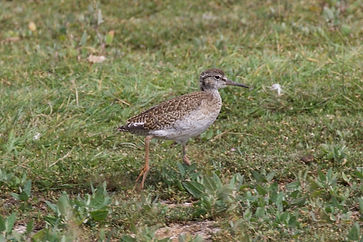
Sandpipers (Tringa)
A family of medium sized waders with medium length bills and legs. Contains the 'shanks' with their brightly coloured legs. They are mainly passage migrants in the UK.
Common Sandpiper - I have grouped the 'Common Sand' in with the Tringa family as it is very similar in many ways, but is actually a member of the Actitis family, like the Spotted Sandpiper.
It is largely a summer breeding migrant here. Similar to the Green Sandpiper but slightly smaller and browner in colour. It's a small wader and it's best distinguishing feature is the white wedge in front of the folded wing. Plus it constantly bobs up and down as it feeds and stands.


I couldn't believe my luck when this bird came right upto the hide I was sitting in, in perfect evening light. WMBC Belvide - July.
Greenshank - I love this elegant wader. They are only Spring & Autumn passage migrants so there's little chance of getting bored of seeing them. They are the same size and shape as Redshank, but as the name suggests they have green legs. Plus they are generally paler and have a slightly upturned bill.

RSPB Leighton Moss - Sept

Falington Marshes nr Portsmouth - Oct

Isles of Scilly - Sept
Green Sandpiper - 'Green Sands' are generally seen between late Summer and the end of Winter, choosing to breed elsewhere. They have greenish legs, like the Greenshank, but are smaller, dumpier, shorter legged and shorter billed. Larger than the Common Sandpiper though. They have a distinctive white rump in flight. This is another bird that bobs its tail up and down whilst standing or feeding. Similar to the Wood Sandpiper but more frequently seen and for a greater portion of the year. Greens have less patterned upper plumage and a less obvious eye stripe.



Another lucky encounter. This young bird performed beautifully right infront of the hide at Warks WT's Brandon Marsh Reserve in Feb 23.
Redshank - Although mobile Redshank can be seen in good numbers all year round. They are a common breeder here. They tend to congregate in larger numbers in Winter, when they are primarily seen on the coast or on estuaries. Their legs can be unbelievably bright orange at times.




Photo 1 is a winter bird. 2 is a Spring breeding bird. 4 shows a young juvenile and 5 a group at a high tide roost.

Spotted Redshank - Another very elegant wader. Very similar to Redshank but longer legged and longer billed and with a white stripe in front of the eye. Generally seen as passage migrants when they are sometimes seen in their startling different breeding plumage - black. Not a bird that's generally seen in any great number.

This lovely bird was seen in Poole Harbour in February.
Wood Sandpiper - Another passage migrant. Not easy to see. They drop into inland wetland areas on passage to and from their breeding grounds, but usually only as individual birds and then they don't tend to hang around for long. It's taken me ten years to get a decent, close-up sighting, A very attractive bird though. Notable features are very spotted feathers on the back, a bold pale stripe above the eye and dull yellow to olive legs.


Taken at RSPB Middleton Lakes, Staffs in mid-August